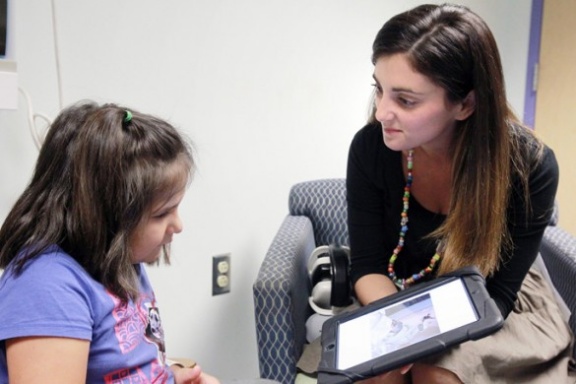Natalie Ortiz is a typical six-year-old first grader — happy, active and fidgety — the kind of patient often sedated for a lengthy Magnetic Resonance Imaging (MRI) scan.
But with the help of a new sedation-free MRI program at the Monroe Carell Jr. Children’s Hospital at Vanderbilt, Ortiz was able to successfully complete a 90-minute scan of her spine recently, lying still in the tube surrounded by a giant circular magnet that loudly clanged, tapped and thumped around her.
The PAWS program (Patient Awake While Scanned) empowers pediatric patients to complete MRI scans without receiving general anesthesia. It’s a carefully orchestrated program, offered from 4-7:30 p.m. five days a week, and led by two Certified Child Life Specialists who work in Pediatric Diagnostic Imaging, a section of the Department of Radiology and Radiological Sciences.
The Child Life Specialists work with Doctors’ Office Tower clinics to identify children who might be eligible. After an assessment phone call, they meet with the patient and parent or guardian immediately before the scan to carefully explain the process.
“Avoiding anesthesia not only makes the process much more pleasant for the family and child, but also safer,” said Marta Hernanz-Schulman, M.D., professor of Radiology and Radiological Sciences and Pediatrics and medical director of Diagnostic Imaging.

There is always a risk with administering anesthesia — drug reactions and interactions or apnea. Also, a child who is sedated and can’t feel pain or discomfort can’t alert the technician if a problem occurs, she said.
Even adults have difficulty remaining still for lengthy MRI scans, said Sarah Beth Gray, a Child Life Specialist who works in Pediatric Radiology.
“Scans can last anywhere from 45 minutes to several hours. Lying still plus the loud banging and knocking noises can cause the child to have challenges with coping,” Gray said.
“With the PAWS program, we can give the patient a clear expectation of what’s going to happen. We show them pictures of the scanner, let them listen to MRI sounds, and try on movie goggles and headphones that they can use during the procedure to watch a movie or listen to music. Children tend to cope better when distracted and engaged in something other than the procedure. A lot of children with chronic illnesses come to Children’s Hospital for MRI scans every three to six months or yearly,” she said.
Currently, about 60 percent of Vanderbilt pediatric patients who have MRIs are sedated, according to Jeffrey Palmucci, B.S., CRA, RT (R), administrative director of Pediatric Diagnostic Imaging. PAWS was tested on Sundays from August 2012-April 2013. All 20 patients, ages 5-16, completed their MRIs without sedation in the pilot program.
Schulman said that MRI examinations require multiple sequences, and that each sequence can take from several seconds to several minutes. “There can be no motion at all during the acquisition of the sequence,” she said, noting that children younger than 5 generally require sedation.
“Obtaining studies without sedation in such young children requires a large investment of time, patience and expertise in child development and the unique needs of the hospitalized child. That is what is so impressive about our PAWS program,” she said.
Natalie, from Portland, Tenn., was being scanned because she has Klippel-Feil Syndrome, a rare disorder characterized by the congenital fusion of any two of the seven cervical (neck) vertebrae.
The most common signs of the disorder are short neck, low hairline at the back of the head, and restricted mobility of the upper spine.
“I don’t want her to be put to sleep any more than she has to,” said her mother, Nicole Ortiz.
Ortiz and Suzanne Grissom, Natalie’s first-grade speech therapist, accompanied the dark haired, dark eyed child to Children’s Hospital for the 6:30 p.m. scan.
Just before the procedure, Natalie, her mother and Grissom went into a small room near the MRI scanner where Gray explained the procedure.
“You’re going to lie on a bed, watch a movie and have some pictures taken,” Gray said, showing Natalie photos on an iPad of the MRI scanner that is decorated with stickers of Shrek and Spiderman.
Gray also let Natalie listen to MRI noises on the iPad, and asked her what they sounded like. “A fire truck? The police? Somebody calling me (on a phone)?” Natalie said.
Next, Gray handed Natalie a pair of movie goggles and headphones that are equipped with a button that can be pushed to talk to the technician doing the scan. Natalie chose Sponge Bob from a selection of movies. “You need to be very still,” Gray said.
“You can’t scratch your head or kick your feet or cross and uncross your legs. If you move around your pictures are going to be blurry, but I think you’re going to do a real good job.”
Using a narrow blue nylon tube Natalie also practiced being very still. She climbed in wearing her movie goggles and earphones and kept her hands tightly by her side, not moving at all.
Besides the confidence that mastering an MRI without sedation affords young patients, other benefits include the ability to eat before the procedure (food and liquids are restricted before general anesthesia), less time in the hospital and a lower cost for the procedure because no anesthesia is used.
If the patient attempts the procedure without sedation and fails, there is no charge, and the family simply schedules another time to have the procedure done with sedation.
Natalie left Children’s Hospital happy that she didn’t have to be sedated for her MRI scan, and clutching a certificate of bravery plus a $5 Ben and Jerry’s gift card for the Children’s Hospital food court.
For more information about the PAWS program, contact a Radiology Child Life Specialist at 322-5853.
